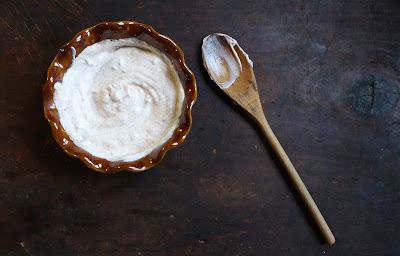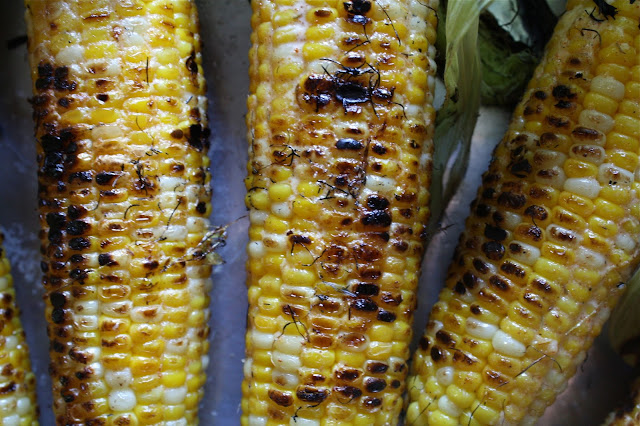Over the course of the next few weeks, there will be an over abundance of zucchini ready for harvesting in gardens and available for sale at farmer's markets. While there may be no scientific evidence to prove otherwise, there will be more loaves of zucchini bread baked during the months of August and September than there will be enough room in every freezer to store them. We will collectively be on zucchini bread overload, weary of anyone we know having a bumper crop of zucchini growing in their gardens and convinced their bread recipe would win the blue ribbon at every county fair within two hundred miles. Secretly we hope after receiving a third loaf of zucchini bread, the next gift of zucchini is simply in its' freshly harvested form. Not just so we can out do the zucchini bread bakers by making an infinite number of jars of zucchini pickles, but so we can use them to make a cold refreshing zucchini crudi or fry up a batch of zucchini ricotta fritters.
If you have been a big fan of potato pancakes or latkes (and really, who isn't?), it is quite possible you will switch your allegiance to zucchini ricotta fritters, temporarily during the late summer months, if not permanently. Not only because the fritters are much easier to make (along with no worries about discoloration), they are layered with flavor. From the scallions, to the garlic, to the lemon zest, to the fresh ricotta, and of course, to the zucchini, you will be indulging your taste buds to the point of spoiling them rotten.
Before the zucchini from your garden or sold at the farmer's markets become baseball bat size, harvest or buy them while they are still growing, while they are their most flavorful and while they have the best skin to flesh ratios.
If possible, use a combination of the dark green, light green and/or yellow zucchini. While they all taste exactly the same, their grated skins make for a more colorful fritter.
As allowing the grated zucchini to drain when making zucchini bread is important, it is almost critical in the making of these fritters. By reducing some of the moisture in the zucchini, the fritter will be crispier when fried. And no one wants to eat a soggy fritter.
If you can find fresh sheep's milk ricotta, buy it. But if you can't, any high quality fresh ricotta (the one you find in the deli counter) will do. And if by chance you are so inclined to make your own fresh ricotta (on the day of making these fritters I wasn't so inclined), go for it.
After all of the ingredients are mixed together, extra-virgin olive oil is heated in the skillet until it is shimmering. At that point, it is a perfect temperature for sautéing and frying. You know your oil is at the shimmering point when it is nice and hot, but not yet smoking. When the oil forms 'tines' like those on a wine glass. It may even have an iridescent color to it. When it reaches this point, your reduce the likelihood of your food sticking to the bottom of the pan or worse, soaking up all of the oil.
The sautéing and/or frying time on the fritters will range slightly depending on how large you make them. For fritters made with approximately two tablespoons of the batter, the total cooking time will range between 3 to 4 minutes. Both sides of the fritter should be cooked until they are a beautiful golden brown. The cooked fritters are transferred to a baking sheet or platter lined with a paper towel to allow some of the moisture from the oil to be absorbed.
Once all of the fritters have been made, they are transferred to a platter for serving. The fritters can be cooked at least two hours ahead of serving, left out at room temperature, and reheated on a baking sheet in a 325 degree preheated oven. During the reheating process the fritters will re-crisp.
These fritters can simply be serve with lemon wedges, but for added flavor serve with labna, sour cream, or a yogurt/lemon juice mixture. Labna is a Middle Eastern soft and tangy cows milk yogurt cheese, one creamier, tangier and thicker than yogurt. It is incredibly delicious all on its' own, without the addition of any olive oil, lemon juice, or fresh herbs. Honestly, I think I liked it more than sour cream.
Pick or pick up some zucchini this weekend. Invite over family or friends and make a platter of these zucchini ricotta fritters. They are bound to turn the most non-effusive of your friends into people you barely recognize. Those that claim they are not big fans of any food sautéed in extra-virgin olive oil, well they will be eating their words after taking a bite of these fritters. And oh, the self-professed 'sorry but I don't like zucchini' people, they will have a religious conversion experience.
RecipeZucchini Ricotta Fritters (inspired by Mario Batali's Zucchini-Ricotta Fritters recipe shared in Food and Wine, August 2011)
Ingredients
2-3 zucchini (about 14-16 ounces), coarsely grated (if possible, choose a combination of dark green, light green and/or yellow skinned zucchini)
2 large garlic cloves, minced
3-4 scallions, green and white parts, thinly sliced
1/2 cup fresh ricotta cheese, homemade or store bought
2 large eggs, room temperature
2 teaspoons finely grated lemon zest
1 teaspoon kosher salt
1 teaspoon black pepper
3/4 cup all-purpose flour
1/8 teaspoon baking powder
extra-virgin olive oil
sea salt for finishing
Lemon wedges
Labna, yogurt/lemon juice mixture and/or sour cream
Directions
1. Line a baking sheet with paper towels. Spread coarsely grated zucchini. Allow zucchini to drain for approximately 30 minutes. Roll up paper towel, squeezing out any additional liquid.
2. In a large bowl, combine garlic, scallions, lemon zest, eggs, ricotta, salt, pepper, and grated/drained zucchini.
3. Mix in flour and baking soda, stirring until flour is fully incorporated.
4. Line a large platter or baking sheet with paper towels. Set aside.
5. In a large skillet, heat 1/4 inch of olive oil until shimmering.
6. Working in batches, add 2 Tablespoon mounds of the zucchini batter into the hot oil. Fry over medium-high heat, turning once until browned and crisp on both sides. Approximately 3-4 minutes of cooking time. Placed cooked fritters on prepared baking sheet to allow fritters to drain.
7. Transfer fritters to a platter, sprinkle with sea salt. Serve immediately with lemon wedges, labna (Middle Easter yoghurt), yogurt/lemon juice mixture (1 cup plain yogurt and 1 Tablespoons lemon juice mixed together) and/or sour cream.
Note: The fritters can be kept at room temperature for up to 2 hours. In a preheated 325 degree (F) oven, recrisp the fritters before serving.
An August sunset in Wheaton, Illinois.





















































